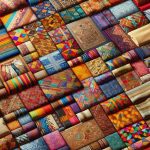Do you want to learn about the stunning artistry of batik silk fabric? Look no further!
In this article, we’ll delve into the rich history, traditional techniques, and unique characteristics of batik silk.
Discover how this exquisite fabric is used in various applications and learn how to care for it properly.
Get ready to be captivated by the beauty and versatility of batik silk fabric.
Let’s dive in and explore this fascinating world together!
Table of Contents
History of Batik Silk Fabric
The history of batik silk fabric can be traced back to ancient Indonesia. Batik silk production techniques have been a part of Indonesian culture for centuries. The process involves applying wax to silk fabric in specific patterns and then dyeing the fabric to create intricate designs. This technique requires great skill and precision, as the wax must be applied carefully to prevent bleeding of the dyes.
The cultural significance of batik silk is immense in Indonesia. It is considered a national treasure and is often worn during important ceremonies and events. The patterns and motifs on batik silk hold deep meanings and symbols, representing various aspects of Indonesian culture and heritage. Each region of Indonesia has its own unique style of batik silk, showcasing the diversity and richness of the country’s traditions.
Today, batik silk is not only popular in Indonesia but also valued worldwide for its beauty and craftsmanship. It has become a symbol of Indonesian identity and a cherished art form that continues to be passed down through generations.
Traditional Batik Silk Techniques
You can easily recognize traditional batik silk techniques by the intricate patterns and vibrant colors. Traditional batik designs are created using a wax-resist dyeing process.
The batik silk production process starts with a plain silk fabric that is washed and stretched on a frame. Then, the design is drawn onto the fabric using a pencil or a tjanting tool.
Next, hot wax made from beeswax and paraffin wax is applied to the fabric using a canting (a small copper container with a spout). The wax acts as a barrier, preventing the dye from penetrating the fabric.
The fabric is then dipped into a dye bath, and the dye seeps into the areas not covered by wax, creating the desired colors. After dyeing, the fabric is boiled to remove the wax, revealing the intricate batik design.
Characteristics of Batik Silk Fabric
One of the characteristics of batik silk fabric is its ability to showcase intricate patterns and vibrant colors. Batik silk production involves a meticulous process of dyeing and wax-resist techniques.
The fabric is first stretched on a frame, and the design is outlined using a canting, a tool with a small spout. Hot wax is then applied to the fabric, creating a barrier to prevent the dye from penetrating certain areas. The fabric is then dyed in a series of baths, with each bath adding a new layer of color. After the dyeing process, the fabric is boiled to remove the wax, revealing the intricate patterns.
Batik silk fabric holds great cultural significance in many societies. It is often used to create traditional clothing, ceremonial garments, and decorative items. In many cultures, the intricate patterns and vibrant colors of batik silk are symbolic of religious or spiritual beliefs, and are worn to signify social status or mark important life events.
The process of creating batik silk is also seen as a form of artistic expression and craftsmanship, passed down through generations. The cultural significance of batik silk extends beyond its aesthetic appeal, serving as a means of preserving cultural heritage and identity.
Uses and Applications of Batik Silk Fabric
When considering uses and applications, think about incorporating batik silk fabric into your home decor for a touch of elegance and cultural flair. Batik silk fabric is not only popular in fashion trends, but it also has numerous benefits when worn.
The intricate designs and vibrant colors of batik silk make it a perfect choice for clothing items such as dresses, blouses, and scarves. Its lightweight and breathable nature make it comfortable to wear in warm weather, while its natural sheen adds a luxurious touch to any outfit.
In addition to clothing, batik silk fabric can be used in various ways to enhance your home decor. You can use it as a statement piece by draping it over a chair or couch, or even framing it as a unique wall art. Batik silk fabric can also be used to create beautiful throw pillows or table runners, adding a touch of sophistication to your living space. Its intricate patterns and vibrant colors will bring a sense of culture and tradition to any room.
Furthermore, wearing batik silk fabric has its benefits. Silk is known for its hypoallergenic properties, making it a suitable choice for those with sensitive skin. It is also highly breathable, allowing air to circulate and keeping you cool in hot weather. Additionally, silk has natural temperature-regulating properties, keeping you warm in colder temperatures. Its smooth texture is gentle on the skin, reducing friction and preventing wrinkles.
Differences Between Batik Silk and Other Silk Fabrics
To distinguish between batik silk and other silk fabrics, it’s important to consider their unique patterns and textures. Here are some key differences to help you identify batik silk:
-
Batik silk fabric is made using a traditional Indonesian dyeing technique called batik, where wax is applied to the fabric to create intricate patterns. Other silk fabrics may have different patterns or no patterns at all.
-
Batik silk has a distinct texture due to the wax-resist dyeing process. It can feel slightly raised or textured to the touch. Other silk fabrics may have a smoother texture.
-
Batik silk often features vibrant colors and bold designs. Other silk fabrics may have more muted colors or simpler designs.
-
Batik silk is typically handmade and each piece is unique. Other silk fabrics may be mass-produced, resulting in less individuality.
-
Batik silk is associated with Indonesian culture and heritage. Other silk fabrics may come from different regions or have different cultural significance.
Understanding these differences can help you appreciate the beauty and craftsmanship of batik silk. Whether you’re a collector or simply an admirer of silk fabrics, recognizing the unique qualities of batik silk adds depth to your knowledge of silk fabric types and silk fabric production.
Care and Maintenance of Batik Silk Fabric
When it comes to caring for your batik silk fabric, it’s important to know how to wash it properly, remove any stains, and preserve its vibrant colors.
By following the proper washing instructions, such as hand washing in cold water with mild detergent, you can ensure that your silk fabric stays in great condition.
Additionally, if you encounter any stains on your silk fabric, it’s crucial to treat them promptly and gently to avoid causing any damage to the fabric.
Lastly, by avoiding exposure to direct sunlight and storing your silk fabric in a cool, dry place, you can help preserve its vibrant colors for years to come.
Washing Silk Properly
It’s important to be careful when washing batik silk fabric. Silk is a delicate material that requires special care to maintain its beauty and longevity. Here are some tips to help you properly wash your silk garments:
- Use cold water: Hot water can damage the delicate fibers of silk, so always opt for cold water when washing.
- Use a gentle detergent: Choose a mild detergent specifically formulated for delicate fabrics like silk.
- Hand wash or delicate cycle: Either hand wash your silk garments or use the delicate cycle on your washing machine.
- Avoid harsh rubbing: Gently swirl the fabric in the water to clean it without causing any damage.
- Air dry: Lay your silk garment flat on a clean towel and let it air dry. Avoid wringing or twisting the fabric.
Removing Stains From Silk
If you spill something on your silk garment, gently blot the stain with a clean cloth to remove it. Silk is a delicate fabric that requires special care when it comes to stain removal.
One important tip for removing stains from silk is to act quickly. The longer a stain sits on the fabric, the harder it will be to remove. Avoid rubbing or scrubbing the stain, as this can damage the fibers. Instead, gently blot the stain with a clean cloth or paper towel.
For stubborn stains, you can try using a mild detergent or a specialized silk stain remover. Always test any cleaning product on a small, inconspicuous area of the fabric first to ensure it won’t cause any damage. Additionally, it’s important to avoid using harsh chemicals or bleach on silk, as they can weaken the fibers and cause discoloration.
To maintain the beauty of your silk garments, it’s recommended to dry clean them or hand wash them using a gentle detergent. Avoid twisting or wringing the fabric, and instead, gently squeeze out excess water and lay the garment flat to dry.
Preserving Silk’s Vibrant Colors
Now that you know how to remove stains from silk, it’s important to learn how to preserve its vibrant colors and protect it from fading. Silk is a delicate fabric that requires special care to maintain its beauty.
Here are some tips to help you keep your silk looking its best:
-
Avoid direct sunlight: UV rays can cause silk to fade over time, so keep it away from windows or use curtains to block out sunlight.
-
Hand wash gently: Use a mild detergent and cold water to clean your silk. Avoid wringing or twisting the fabric.
-
Air dry flat: Hang your silk garments or lay them flat to dry. Avoid using a dryer, as the heat can damage the fabric.
-
Store properly: Fold your silk items and store them in a cool, dry place. Avoid hanging them, as this can cause stretching.
-
Handle with care: Be gentle when wearing or handling silk to prevent pulling or snagging.
Conclusion
In conclusion, you now have a clear understanding of what batik silk fabric is.
You have learned about its rich history, traditional techniques, and unique characteristics.
You also discovered the various uses and applications of this fabric, as well as the differences between batik silk and other silk fabrics.
Lastly, you gained knowledge on how to properly care for and maintain batik silk fabric.
With this information, you can confidently appreciate and utilize batik silk fabric in your own projects.
- Jaclyn Smith Fabric Coconut: a Review of This Rayon/Polyester Blend - June 29, 2025
- Jaclyn Smith Fabric Coconut: a Review of This Rayon/Polyester Blend - June 29, 2025
- How to Get Coconut Oil off Fabric Without Washing - June 29, 2025






